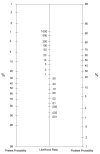The assessment of children and adolescents with bipolar disorder
- PMID: 19264268
- PMCID: PMC2915577
- DOI: 10.1016/j.chc.2008.12.002
The assessment of children and adolescents with bipolar disorder
Abstract
The overarching goal of this article is to examine the current best evidence for assessing bipolar disorder (BPD) in children and adolescents and provide a comprehensive, evidence-based approach to diagnosis. Evidence- based assessment strategies are organized around the "3 Ps" of clinical assessment: Predict important criteria or developmental trajectories, Prescribe a change in treatment choice, and inform Process of treating the youth and his/her family. The review characterizes BPD in youths-specifically addressing bipolar diagnoses and clinical subtypes; it then provides an actuarial approach to assessment using prevalence of disorder, risk factors, and questionnaires; discusses treatment thresholds; and identifies practical measures of process and outcomes. The clinical tools and risk factors selected for inclusion in this review represent the best empirical evidence in the literature. By the end of the article, clinicians will have a framework and set of clinically useful tools with which to effectively make evidence-based decisions regarding the diagnosis of BPD in children and adolescents.
Figures
Similar articles
-
Borderline personality disorder and mood spectrum.Psychiatry Res. 2008 Jun 30;159(3):300-7. doi: 10.1016/j.psychres.2007.10.002. Epub 2008 Apr 29. Psychiatry Res. 2008. PMID: 18445508
-
Focus on Disruptive Mood Dysregulation Disorder: A review of the literature.Psychiatry Res. 2019 Sep;279:323-330. doi: 10.1016/j.psychres.2019.05.043. Epub 2019 Jun 1. Psychiatry Res. 2019. PMID: 31164249 Review.
-
Severe mood dysregulation, irritability, and the diagnostic boundaries of bipolar disorder in youths.Am J Psychiatry. 2011 Feb;168(2):129-42. doi: 10.1176/appi.ajp.2010.10050766. Epub 2010 Dec 1. Am J Psychiatry. 2011. PMID: 21123313 Free PMC article.
-
Comparing anxiety disorders and anxiety-related traits in bipolar disorder and unipolar depression.J Psychiatr Res. 2003 May-Jun;37(3):187-92. doi: 10.1016/s0022-3956(03)00021-9. J Psychiatr Res. 2003. PMID: 12650739
-
Mood disorders in children and adolescents.J Pediatr Nurs. 2009 Feb;24(1):13-25. doi: 10.1016/j.pedn.2008.04.007. Epub 2008 Oct 15. J Pediatr Nurs. 2009. PMID: 19159832 Review.
Cited by
-
An inexpensive family index of risk for mood issues improves identification of pediatric bipolar disorder.Psychol Assess. 2013 Mar;25(1):12-22. doi: 10.1037/a0029225. Epub 2012 Jul 16. Psychol Assess. 2013. PMID: 22800090 Free PMC article.
-
Generalizability of evidence-based assessment recommendations for pediatric bipolar disorder.Psychol Assess. 2012 Jun;24(2):269-81. doi: 10.1037/a0025775. Epub 2011 Oct 17. Psychol Assess. 2012. PMID: 22004538 Free PMC article.
-
Characteristics of children with elevated symptoms of mania: the Longitudinal Assessment of Manic Symptoms (LAMS) study.J Clin Psychiatry. 2010 Dec;71(12):1664-72. doi: 10.4088/JCP.09m05859yel. Epub 2010 Oct 5. J Clin Psychiatry. 2010. PMID: 21034685 Free PMC article.
-
Neurocognitive performance in children and adolescents with bipolar disorder: a review.Eur Child Adolesc Psychiatry. 2011 Sep;20(9):433-50. doi: 10.1007/s00787-011-0209-x. Epub 2011 Sep 9. Eur Child Adolesc Psychiatry. 2011. PMID: 21904806 Review.
-
Unfiltered Administration of the YMRS and CDRS-R in a Clinical Sample of Children.J Clin Child Adolesc Psychol. 2015;44(6):992-1007. doi: 10.1080/15374416.2014.915548. Epub 2014 Jun 2. J Clin Child Adolesc Psychol. 2015. PMID: 24885078 Free PMC article.
References
-
- Moreno C, Laje G, Blanco C, et al. National Trends in the Outpatient Diagnosis and Treatment of Bipolar Disorder in Youth. Archives of General Psychiatry. 2007;64:1032–1039. - PubMed
-
- Klein RG, Pine DS, Klein DF. Resolved: Mania is mistaken for ADHD in prepubertal children. Journal of the American Academy of Child & Adolescent Psychiatry. 1998;37:1093–1096. - PubMed
-
- Faraone SV, Glatt SJ, Tsuang MT. The genetics of pediatric-onset bipolar disorder. Biological Psychiatry. 2003;53:970–977. - PubMed



